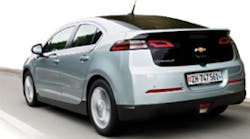The vehicle itself, a Chevrolet Volt, remained static (see photo). Yet it was nonetheless impressive, as it showed how everyone in a vehicle will eventually have access to streaming content from the Verizon 4G LTE cloud-computing network (which is connected to literally millions of databases and computers) working in conjunction with OnStar's Advanced Telematics Operating System (ATOMS). Access to streaming content was among the prototype applications demonstrated at CES.
Thanks to the 4G LTE network, passengers could eventually have access to streaming content from their home computers or via a popular streaming service. They also could share content throughout the vehicle. With rear-seat infotainment management using an advanced human-machine interface (HMI), the user could independently control the two rear zones. This capability will provide the transmission of cached or streaming contentincluding music, videos, games, and newsto each rear passenger. Video chat also could become more widely available, as passengers will be able to make a Skype video call from the vehicle to a home, mobile device, or another vehicle.
The concept car also flaunts OnStar's efforts in smart-grid technology and home connectivity, which it has utilized to develop in-vehicle energy-management applications. By integrating the OnStar RemoteLink mobile application, for example, the Volt owner could access remote vehicle information and services. Also on display were real-time diagnostics and eco-routing. With these applications, Chevy Volt drivers could access their charge status, get a reading of the distance left on the remaining charge, and find and reserve charging locations. They even could manage pertinent Volt information and vehicle diagnostics.
Impressively, home energy management also could be included, with OnStar users controlling their home thermostats, lights, garage doors, and other electronic systems directly from the vehicle. Of course, the applications shown in the Chevrolet Volt research vehicle are only conceptual. Yet they demonstrate future opportunities that could be provided by the OnStar ATOMS Cloud capabilities in combination with broadband accessibility. OnStar's advanced innovation engineering team will continue to collaborate with Verizon's LTE Innovation Center to further investigate the potential of the connected vehicle.

